About two-thirds of pregnant woman get Diastasis recti.  This is muscle separation in the stomach during pregnancy. The growth of the stomach pushes the muscle columns apart.
This is muscle separation in the stomach during pregnancy. The growth of the stomach pushes the muscle columns apart.
It is important to note that the stats mentioned above may well include those with slight muscle separation as opposed to a large more serious separation. This is why many pregnant women can continue with exercise as normal for many months after conception.
The best way to avoid this is to strengthen the muscles before pregnancy or during the very early stages. Be sure to consult with your doctor regarding exercise in terms of what you can and cannot do.
The risk of a larger separation of the muscle columns is heightened when pregnancy is soon after another or if you are over 35. Also having multiple births increases the risk of Diastasis recti (recti refers to your ab muscle which is called “Rectus Abdominis”. Diastasis is Latin for separation).
Due to the abdominal muscles moving aside the uterus and other organs are only protected by a thin band of tissue. This can make a vaginal birth more difficult when the muscle support is reduced.
In addition, any loss of frontal stomach muscle can lead to lower back pain.
Other symptoms linked to Diastasis recti are urine leakage, constipation, hard to breathe and movement difficulty. In extreme but very rare cases the tissue may break allowing organs to protrude (known as a hernia).
The good news is that the muscle gap shrinks after birth and return to normal soon after giving birth. In some rare cases, it has been known to take up to 12months to recover but most cases go back to normal soon after birth.
Advice:
Avoid strain when lifting and laying, including picking up your children. Even standing and sitting is classed as strain because you are lifting your whole body.

During the act of birth push down but ensure you ask any midwife/medical consultant how to correctly push if you have this condition.
When/if you do exercise, avoid core strengthening such as planks, press-ups and so on because these can exacerbate muscle separation issues. Indeed even swimming is not recommended.
On a day to day basis, the general idea is not to agitate the muscles as to increase the chances of further separation. It may be useful to use a belly splint to hold the muscles together more too.
However, once you have had the baby it and the healing starts Pilates may help you heal quicker. But do consult with a doctor and the instructor to ensure you do the right thing.
Be sure to consult your doctor regarding how to bring those muscles back together and strengthen them before getting pregnant again.
If you are still struggling to get your tummy back to its original shape and strength there are surgical procedures which can help but it’s best to talk to your doctor about those.
To help with lifting and laying a baby after pregnancy as well as healing back pain then click here.


